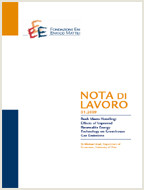Static and Dynamic Efficiency of Irreversible Health Care Investments under Alternative Payment Rules

02.10.2010
Rosella Levaggi, Michele Moretto, Paolo Pertile
I18, D92
Health Care, Investments
Economy and Society
Fausto Panunzi
The paper studies the incentive for providers to invest in new health care technologies under alternative payment systems, when the patients’ benefits are uncertain. If the reimbursement by the purchaser includes both a variable (per patient) and a lump-sum component, efficiency can be ensured both in the timing of adoption (dynamic) and the intensity of use of the technology (static). If the second instrument is unavailable, a trade-off may emerge between static and dynamic efficiency. In this context, we also discuss how the regulator could use the control of the level of uncertainty faced by the provider as an instrument to mitigate the trade-off between static and dynamic efficiency. Finally, the model is calibrated to study a specific technology.
